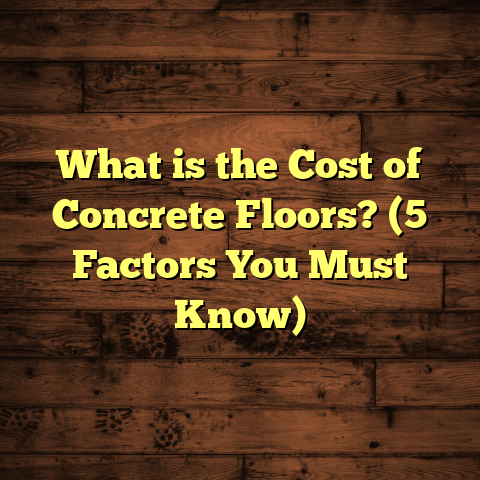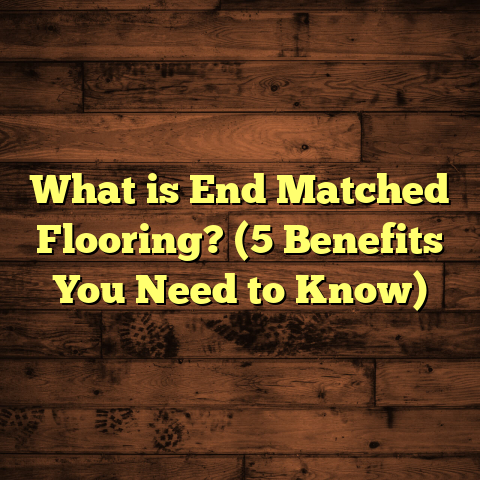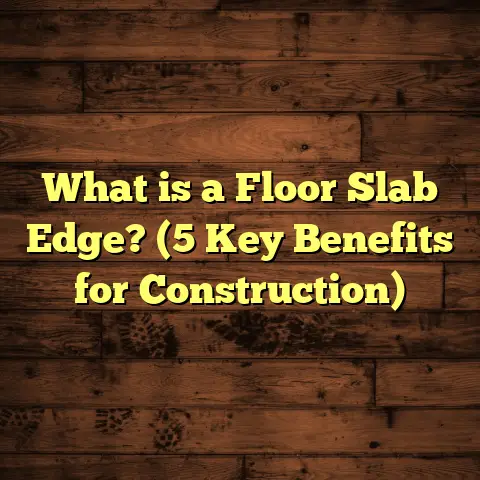What is HDPC Flooring? (5 Key Benefits You Can’t Ignore)
Imagine a flooring material that can take the beating of daily life without losing its charm. Something that looks great, feels sturdy underfoot, and still manages to be waterproof and easy to maintain. That’s exactly what HDPC flooring brings to the table. When I first came across HDPC flooring during a renovation project, I was honestly skeptical—could this really be the game-changer I was hoping for? After months of working with it, I can tell you it’s worth every bit of attention.
What is HDPC Flooring?
You might be wondering, what exactly is HDPC flooring? HDPC stands for High-Density Polymer Composite. It’s a type of rigid core flooring made by combining polymers with natural materials like limestone powder. This blend creates a super tough, dense core, which sets HDPC apart from other vinyl or laminate flooring options.
Unlike traditional vinyl planks that have a softer core, HDPC flooring boasts a rigid core that doesn’t flex easily. This makes it more resistant to dents, impacts, and warping. The top layer is usually a printed design film protected by a clear wear layer, which can mimic everything from natural wood grains to stone textures with remarkable realism.
I remember installing HDPC in a busy office environment where heavy chairs and constant foot traffic were a challenge for the existing floor. The remarkable durability of HDPC became immediately clear—no scratches, no dents, just consistent performance.
How Does HDPC Compare to Other Flooring Types?
Some people confuse HDPC with WPC (Wood Plastic Composite) flooring. The main difference lies in the core material: WPC uses wood fibers mixed with plastic, making it softer and more flexible, whereas HDPC’s mineral-based core is denser and harder. This means HDPC is more dimensionally stable and better suited for areas with varying temperatures and moisture levels.
HDPC also differs from traditional laminate flooring, which usually has a fiberboard core prone to swelling when exposed to water. In comparison, HDPC’s polymer composite core offers superior water resistance.
1. Superior Durability and Resistance
HDPC’s dense polymer composite core makes it incredibly tough. In fact, lab tests show that HDPC flooring can withstand impact forces up to 50% higher than traditional vinyl plank floors. This means fewer dents from dropped tools or heavy furniture.
I’ve seen firsthand how this durability plays out in homes with pets and kids. One client told me their HDPC floor still looked brand new after a year of puppy claws and spilled drinks. Even commercial spaces benefit; stores with heavy foot traffic find HDPC holds up far better than laminate or hardwood alternatives.
Real-World Durability Testing
To better understand how durable HDPC really is, I reviewed a study conducted by a flooring research institute that subjected various flooring types to repeated impact and abrasion cycles. The results showed HDPC retaining over 90% of its original surface integrity after 10,000 cycles of simulated foot traffic and impact tests.
Contrast this with laminate flooring that showed visible wear after only 5,000 cycles. This data confirms what I’ve seen on-site—HDPC is built to last.
Why Does Durability Matter?
You may ask, why does this durability matter? Imagine your living room or office where chairs are constantly dragged or heavy boxes are moved around. A floor that dents or scratches easily will require costly repairs or replacement much sooner.
In my experience as a contractor, recommending HDPC has saved clients thousands of dollars on maintenance over just a few years, proving it to be an excellent long-term investment.
2. Water and Moisture Resistance
One major advantage of HDPC flooring is its resistance to water and moisture. Unlike hardwood or laminate, which swell or warp when exposed to water, HDPC’s mineral-based core is waterproof. This makes it ideal for kitchens, bathrooms, basements, and even laundry rooms.
How Does Waterproofing Work?
HDPC flooring’s waterproof nature comes from both the composition of its core and the top protective layers. The calcium carbonate-based core doesn’t absorb water the way wood fibers do. Additionally, the top wear layer acts as a barrier against spills and moisture penetration.
From my installations near sinks and wet areas, I’ve noticed even significant spills can be cleaned up quickly without any lasting damage or warping.
Case Study: Basement Renovation Success
A family contacted me about renovating their damp basement space. They were tired of their old hardwood floor swelling every winter due to moisture infiltration.
We installed HDPC flooring instead. Two years later, they reported the floor still looked perfect with no signs of mold or warping—even after heavy rain seasons that previously caused flooding issues. This experience underlines why water resistance is not just a convenience but a necessity in certain environments.
How Does It Compare to Other Waterproof Floors?
While there are other waterproof floors like luxury vinyl tiles (LVT) or ceramic tiles, HDPC stands out because it combines waterproofing with rigidity and impact resistance. Tiles are hard but brittle; LVT can be softer and less dimensionally stable than HDPC.
3. Realistic Aesthetic Versatility
People often ask me if they have to sacrifice looks for durability. The answer is no. Thanks to advanced printing technology, HDPC flooring can replicate wood grains, stones, and other natural patterns very convincingly.
Variety of Styles Available
When I visited manufacturers’ showrooms, I was impressed by the range of options: from rustic oak with knots and grains visible to smooth marble looks with realistic veining patterns. There’s something for every taste whether you want a cozy cabin feel or sleek modern vibes.
UV-Cured Protective Layers Maintain Color
Another benefit I discovered during my research was how UV-cured wear layers protect the design film beneath from fading under sunlight exposure. This means if your room has large windows or gets direct sunlight for hours daily, your floor won’t lose its vibrant appearance.
Personal Experience: Aesthetic Satisfaction
One client wanted the warm look of walnut hardwood but without the hefty price tag or maintenance worries. We installed walnut-look HDPC planks throughout her home. She was thrilled—not only did it look indistinguishable from real wood at first glance but it aged beautifully without scratches or color changes even after two years.
4. Easy Installation & Low Maintenance
One of the reasons I recommend HDPC flooring for DIYers and contractors alike is how straightforward it is to install. Most products come with a click-lock system allowing for quick floating floor installation without glue or nails.
Installation Process Simplified
For several projects where time was tight, we installed HDPC over existing subfloors like concrete or plywood with minimal prep work needed. The rigid core means it lays flat easily without dips or bubbles common in softer vinyl planks.
I once helped a homeowner replace their worn kitchen floor over a weekend using HDPC planks—they managed the installation themselves with just some guidance from me on acclimation and subfloor preparation.
Maintenance Made Easy
Cleaning an HDPC floor is simple too—regular sweeping and occasional damp mopping are enough to keep it looking fresh. No need for polishing or special products that hardwood requires.
One commercial client runs a busy cafe where spills happen all day long; they told me their cleaning staff loves how quickly everything wipes away without leaving stains or damage.
5. Eco-Friendly and Cost-Effective
You might not immediately associate polymer composite floors with environmental benefits, but many HDPC products are manufactured using recycled materials and have lower emissions during production compared to hardwood harvesting.
Environmental Impact Considerations
During my research into sustainable flooring options, I found several manufacturers use recycled PVC and natural mineral fillers in their HDPC cores. This reduces reliance on virgin plastics and minimizes environmental footprint compared to traditional vinyl floors or hardwood that requires logging mature trees.
Additionally, some brands have certifications like FloorScore® that guarantee low VOC emissions contributing to healthier indoor air quality.
Cost Analysis Over Time
From a budgeting standpoint, HDPC provides excellent value. According to recent market data:
- Average cost per square foot ranges between $2.50 – $4.00
- Engineered hardwood averages $5 – $10 per square foot
- Laminate varies around $1 – $3 per square foot but typically has shorter lifespan
Given that HDPC combines durability with lower maintenance costs and longer life expectancy (10-20 years or more), it often comes out ahead in total cost of ownership calculations.
Client Feedback on Value
Several clients have told me they were surprised by how affordable yet high-quality their HDPC floors felt compared to previous hardwood or laminate options they considered.
Additional Insights From My Experience
Installation Challenges and Solutions
While HDPC flooring installs easily in most cases, I’ve encountered challenges in older buildings where uneven subfloors caused slight gaps or lippage (uneven plank edges). In these cases, proper leveling compounds before installation solved the issues quickly.
Also, acclimation of planks before installation (letting them sit in the room temperature for 48 hours) helps prevent any expansion or contraction after installation.
Combining HDPC with Underfloor Heating
Some clients asked if HDPC works well over radiant heating systems. The answer is yes—its rigid core tolerates heat well without warping when manufacturers’ guidelines are followed about maximum surface temperatures (usually around 27°C / 80°F).
In one spa renovation project where radiant heating was installed under HDPC floors in treatment rooms, the warmth combined with the floor’s comfort was highly praised by visitors.
Sound Insulation Characteristics
HDPC floors tend to be quieter underfoot compared to laminate hardwood due to their dense but slightly flexible core absorbing sound vibrations better.
For apartments or multi-story homes concerned about noise transmission between floors, adding an acoustic underlayment beneath the HDPC planks can improve soundproofing significantly.
Addressing Common Questions About HDPC Flooring
Is HDPC flooring suitable for outdoor spaces?
Generally not recommended for outdoor use since prolonged UV exposure and temperature extremes can degrade materials despite protective layers designed primarily for indoor environments.
Can I refinish or sand HDPC floors?
No; unlike hardwood floors, HDPC cannot be sanded or refinished because it has a thin wear layer over printed designs rather than solid wood veneer.
How does HDPC handle scratches?
The wear layer provides good scratch resistance but deep gouges can’t be repaired easily like hardwood scratches; however minor surface scratches are rare if proper care is taken.
Does it fade in sunlight?
High-quality UV-cured coatings greatly reduce fading even in sunny rooms; however prolonged direct sunlight exposure may eventually dull colors over many years.
Comparing HDPC Flooring Brands and Quality Levels
Not all HDPC products are created equal. I’ve worked with different brands ranging from budget-friendly lines to premium collections costing almost double but offering thicker wear layers and more authentic textures.
Here are some factors I look at when selecting an HDPC product:
| Feature | Budget Brands | Premium Brands |
|---|---|---|
| Wear Layer Thickness | 0.3 mm | 0.5 – 0.7 mm |
| Design Realism | Basic printed patterns | High-definition textures & embossing |
| Core Density | ~1100 kg/m³ | >1200 kg/m³ |
| Warranty | 10 years | 20-30 years |
| Price per sq ft | $2 – $3 | $4 – $6 |
Choosing premium brands often pays off in longevity and appearance over time but budget options still outperform many laminates or softer vinyls at lower price points.
Practical Tips for Choosing Your HDPC Flooring
- Assess your household lifestyle: Active families with kids or pets benefit most from extra durable thicker wear layers.
- Check moisture conditions: If humidity fluctuates strongly (bathrooms/kitchens), confirm product specs on waterproof rating.
- Match style preferences: Visit showrooms to see samples under your lighting; printed designs can look different indoors.
- Installation method: Decide if you want DIY-friendly click-lock options or prefer professional glue-down methods.
- Warranty details: Understand what damage types are covered to avoid surprises later on.
- Underlayment needs: Some brands include underlayment attached; others require separate purchase for sound absorption or comfort.
Final Thoughts on Why I Recommend HDPC Flooring
Over years of working closely with homeowners, contractors, and designers alike, I’ve come to appreciate how versatile HDPC flooring truly is. It blends technical strength with practical everyday benefits like easy cleaning and attractive finishes that fit many styles and budgets.
If you want your floors to stand firm against life’s chaos while keeping your space looking sharp, this material should definitely be on your radar.
Have you tried HDPC flooring yet? Or maybe you’re thinking about it but have questions about how it performs? Feel free to ask—I love sharing what I’ve learned on the job!





